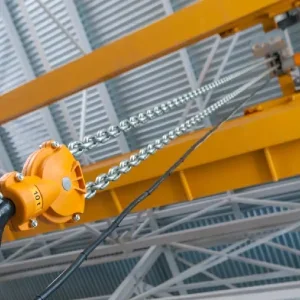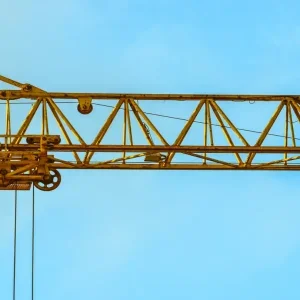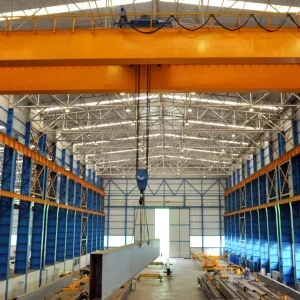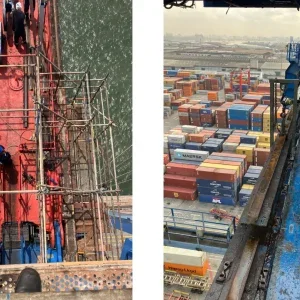A hulking complex of white, windowless blocks and domes, with service roads reaching out across a barren landscape, it could double as the abandoned factory where aliens prepared to conquer Earth in the 1957 sci-fi film Quatermass 2. But this extraordinary place is no work of fiction.

For four decades, from 1954 to 1994, Dounreay was Britain’s centre of fast reactor research and development, where leading scientists and engineers experimented with plutonium, uranium and other metals to develop electricity generation using an advanced type of nuclear reactor.
During the Cold War years, the uranium metal needed to make nuclear energy was very scarce—and Britain needed to conserve what it had for the development of nuclear weapons.
Scientists came up with a way of generating electricity from a new type of reactor that would not jeopardise the weapons programme: the fast breeder reactor would convert an unusable form of uranium into plutonium and in turn into new reactor fuel, ‘breeding’ its own fuel and unlimited electricity.
The UK Atomic Energy Authority began construction of the Dounreay Fast Reactor, Materials Test Reactor and associated chemical works in 1955. The first nuclear reaction in Scotland took place at the facility two years later and, in 1961, Dounreay became the first fast reactor in the world to supply electricity to the national grid. But, while the technology worked and was hailed by the government in 1966 as “the system of the next century”, the Fast Reactor proved to be more expensive than originally estimated and by the 1980s uranium was no longer in scarce supply. The programme was cancelled in 1988, marking the end for Dounreay.
Today, it is Scotland’s largest demolition project. In 2000 the Dounreay Site Restoration Plan set out the 60-year project to decommission the site at a cost of £4.3bn.

The equipment and materials are being removed and the environment around the site restored as near as possible to its original condition. The experimental nature of its former activities make the clean-up and demolition of Dounreay, the disposal of waste, and the need to secure the redundant radioactive materials, one of the most complex nuclear clean-up challenges known in the world.
Of the approximately 180 facilities on site, some 50 involved the presence of radioactive materials and still present chemical or radiological hazards, requiring special controls to contain radiation. Some of the waste generated by decommissioning includes asbestos and radioactive material, which has also polluted the ground, while radioactive particles are present on the seabed and local beaches.
Where radiation levels are too high for workers, even when wearing protective air-line suits and respirators, robotic equipment is used. Long-term plans for the closure and remediation of the site are updated every year.
One such project was the removal in February of a building crane from the redundant decontamination and waste handling facility, known as D1207, which served Dounreay’s chemical plants and the adjoining site of the Royal Navy’s Vulcan submarine test propulsion facility.
The electric overhead travelling (EOT) gantry crane, a single hoist 7.5t Wharton with under-slung cab operation, manufactured in Stockport and installed in D1207 in 1958, had been used to move large items of equipment such as flasks. With a span of 11.5m, it occupied the entire width of the building.

A team of workers from the site licence company DSRL (Dounreay Site Restoration Ltd) and its decommissioning sub-contractors removed the crane, using a much larger crane to lift it through the roof, as part of the operation to reduce the radioactive hazard in the building, leading to its eventual demolition.
DSRL senior project manager Robbie Manson oversaw the project. He explains that, before work could start, the team had to decontaminate the surface of the ceiling and remove the redundant ventilation extract ducting from D1207. A roof hatch was then installed to enable access into the building for the mobile crane outside it. The team had to wait for a relatively calm day—no easy condition to satisfy in this bleak, windswept coastal location—to carry out the manoeuvre.
“The Wharton was parked at the end of the facility and was remotely pulled 20m into the middle of the building, below the purpose-built roof hatch,” says Manson. “An external 130t mobile crane was used for the operation.
“The cross-travel bogie was lifted off the crane and lowered to the floor, while riggers wearing radiation protection clothing and using respirators fixed scaffold poles to the crane to prevent the slings from slipping. The crane was lifted off its rails, turned 90º and lowered to a prepared area on the building floor. The external crane was then used to replace the roof hatch. The building crane and bogie were cut up into sections that could be handled with fork-lift trucks and fit into ISO waste containers for onward storage in the site’s waste stores, and sprayed with two coats of metal paint.”

The complete programme of work took four weeks from installing the roof hatch to removal of the crane as waste. The main lift of the crane from the building to the floor took 14 hours in one day, from 6am to 8pm.
Another major project, carried out last August, was the removal of three enormous metal cylinder tanks from the reactor steam generation building, housed in the PFR (Prototype Fast Reactor). A Babcocks & Wilcox 8069 building crane manufactured around 1960 was used for the job.
The pendant-operated crane has a main hoist (ram’s horn) double hook 50t load capacity and an auxiliary hoist single hook of 7.5t capacity (with safety catch fitted).
Other lifting equipment used for the job included a custom-made spreader beam of 50t and wire strops, synthetic round slings, a variety of shackles, pull lifts and chain blocks of appropriate sizes. “All the lifting equipment was tested, certified in date and given an additional inspection by a LOLER-competent person (approved by Zurich Assurance) prior to use,” adds the project’s manager, Rashid Abdulla.
The first giant tank to be removed was 30ft deep with a weight of approximately 26t. But before the lift could begin, preparatory works were undertaken over some eight weeks, including the physical isolation of electrical and mechanical systems, thermal insulation (including asbestos) and the removal of approximately 20t of pipework, valves, associated brackets, cell roof sections and non-structural steelwork. In addition, civil and structural assessments had to be carried out, including MPI [Magnetic Particle Inspection].
The actual lifting operation took six hours from taking the load on the hook to landing it in the final position. The tank was raised two inches, held for 30 minutes, lowered, the lifting equipment was detached, the MPI repeated on the trunnions for stress cracking, and the lifting equipment re-attached and balanced.

Abdulla explains the complex issues surrounding the project: “The tank was cylindrical in shape, with hemispherical ends approximately 24ft 7in high and 11ft 6in in diameter, standing on its own integrated fully welded skirt with a single 24in penetration, and secured with 1.7/8x24in BSW x 18 studs (grouted) on the inside of the skirt to the floor of the pit.
“It was housed in a below-ground pit, also a confined space. Access to unbolt it required a double confined space entry, watchers and remote video camera surveillance. ‘Man-down’ radios were used to watch and ensure operators’ safety whilst accessing the tank skirt. Remote video camera surveillance was also used when jacking the tank to free it from the pit floor to ensure the load was not restrained or obstructed whilst being lifted. Radios were used throughout. The lifting operation, although simple, was classed as a complex lift for this operation and was planned in accordance with LOLER and Site Procedures.”
The major obstacle, Abdulla says, was space constraints. “There was approximately only four inches of free space between the fixed structural horizontal beam and an active sodium transfer line (isolated and drained) mid height of the cell. The pit was 30ft below ground level, the cell roof at two levels—40ft and 47ft from ground level, excluding the handrail at the 47ft level—and clearance between the tank base and the cell roof at the 47ft level was only five inches.
“The tank had to be perfectly level vertically to ensure the tank cleared all the studs during the lift. During the lifting operations it was manoeuvred north, south, east and west and rotated as required to clear obstructions throughout the lifting stage.
“Once lifted clear of the 40ft cell roof, it was traversed south and then east, and the 47ft handrail and kick plate removed. The tank was raised to the maximum crane travel and then traversed east to align with the penetration on the 47ft level and prepared for lowering into the final position on the ground level of the cell into a bunded area for decommissioning.”
The same Babcocks & Wilcox building crane was used to remove a 30ft high curved metal pipe from 90ft up in the roof void of the former PFR steam generating building. The gigantic hockey stick-shaped structure, weighing 4t, was part of the heat transfer system and would have fed sodium from the secondary circuits into the colossal dump tanks below in the event of an emergency. Each tank had a pipe for effluent and one for vent. The vent pipe was removed a few years ago and the remaining effluent pipe was chopped off and lifted, tilted, turned and lowered to the ground by the building crane.
In April, the Nuclear Decommissioning Authority (NDA) published its annual business plan setting out the key activities scheduled at Dounreay over the next 12 months.
Planned NDA expenditure for Dounreay in 2010/11 is £166m, up from £157m in 2009/10, and includes £2m for work on a national nuclear archive at Wick. Both this and a heritage project for Dounreay are in the early stages of planning, with the heritage project having just completed its consultation period.
Key activities on the site in 2010-11 include the complete integration and active commissioning of the Fuel Cycle Area ventilation system, for which a mobile crane will be used; retrieving offshore particles, in line with the Dounreay Particle Advisory Group recommendations, which will use a submarine ROV; and the encapsulation of 100m3 of highly active liquors in cement at the Dounreay Cementation Plant.
The process for this job takes place in a series of sealed cells.
The crane that lifts the clean drums into position at the beginning of the process is a 7.5t SWL Matterson electric overhead double girder travelling crane, manufactured in 1985.
Another key task for the coming year is beginning the removal of irradiated sub-assemblies from the PFR pond, using the pond transporter, a small crane with a capacity of around 1t.
The body of the crane, which was manufactured by Clarke Chapman some 30 years ago, travels on rails down the length of the pond, with a crab that travels across the pond, also on rails.
Other work to be carried out in 2010/11, though not requiring the use of lifting equipment, includes the destruction of 50% of the liquid metal still inside the Fast Reactor; progress towards a new disposal facility for low-level radioactive waste; liaison with other site licence companies to investigate off-site transfers of fuels to mitigate the long-term requirements for on-site storage and security; and low active drain enabling work for the shaft and silo waste treatment plant.
This year, the Materials Test Reactor reprocessing plant will be decommissioned. Other key milestones for the future are the removal of the breeder from the Dounreay Fast Reactor in 2016, the decommissioning of the fast reactor reprocessing plant in 2021, and all the redundant facilities being cleared in 2025, by which time the decommissioning will have reached interim end state at a cumulative cost of £2.6bn.
The land is expected to be safe for re-use by the year 2294.






